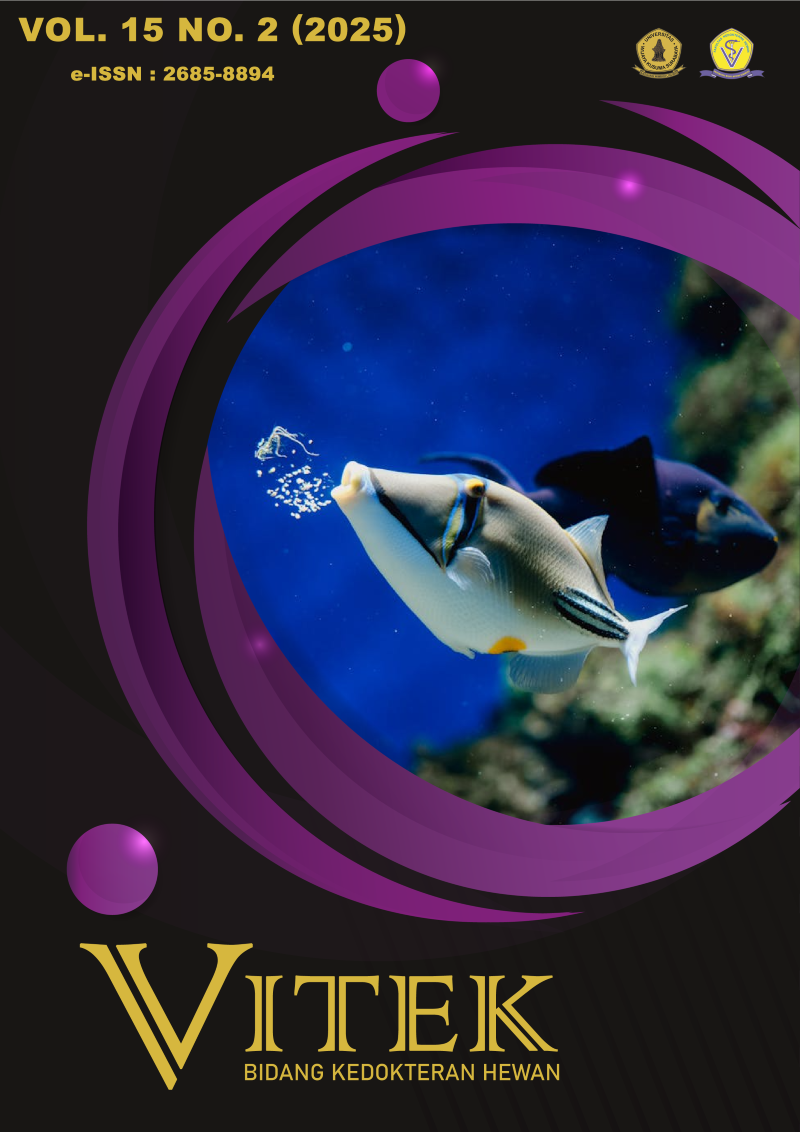LAPORAN KASUS: PANSITOPENIA BERAT AKIBAT EHRLICHIOSIS PADA ANJING LOKAL DISERTAI KOINFEKSI DEMODEKOSIS DAN DERMATOFITOSIS
Main Article Content
Abstract
Ehrlichiosis is caused by bacteria of the genus Ehrlichia, which are transmitted by arthropod vectors, particularly the tick Rhipicephalus sanguineus. Mites of the genus Demodex cause demodicosis, which often occurs secondarily as a result of malnutrition or immunosuppressive conditions in dogs. Dermatophytosis in dogs can be caused by various fungal species, one of which is Microsporum sp., a zoonotic pathogen. This case report discusses a one-year-old local female dog with a combined infection of Ehrlichia canis, Microsporum sp., and Demodex sp. The dog exhibited clinical signs of pruritus, alopecia, skin lesions, and pale mucous membranes. Hematological examination indicated leukopenia, macrocytic hypochromic anemia, and thrombocytopenia. Serological testing revealed the presence of antibodies to Ehrlichia sp. Skin scraping and fungal culture confirmed a Demodex sp. infestation and a dermatophytosis infection caused by Microsporum sp. Treatment included intravenous fluids, doxycycline antibiotics, hematodin, and neurotropic agents. Although the patient initially showed clinical improvement, the condition worsened and ultimately resulted in death. This case emphasizes the importance of early diagnosis and comprehensive management of multi-etiological infections in dogs.
Article Details
Section
How to Cite
References
Barman, D., Baisya, B.C., Sarma, D., Phukan, A., Dutta, T.C. 2014. A case report of canine Ehrlichia infection in Labrador dog and its therapeutic management. Bangladesh Journal of Veterinary Medicine, 12(2), 237-239.
Bond, R. 2010. Superficial veterinary mycoses. Clinics in Dermatology, 28(2), 226-236.
Bottari, N.B., Crivellenti, L.Z., Borin-Crivellenti, S., Oliveira, J.R., Coelho, S.B., Contin, C.M., Tatsch, E., Moresco, R.N., Santana, A.E., Tonin, A.A., Tinucci-Costa, M., Da Silva, A.S. 2016. Iron metabolism and oxidative profile of dogs naturally infected by Ehrlichia canis: acute and subclinical disease. Microbial Pathogenesis, 92, 26-29.
Conlan, J.V., Sripa, B., Attwood, S., Newton, P.N. 2011. A review of parasitic zoonoses in a changing Southeast Asia. Veterinary Parasitology, 182(1), 22-40.
Erawan, I.G.M.K., Sumardika, I.W., Pemayun, I.G.A.G.P., Ardana, I.B.K. 2017. Case report: ehrlichiosis in a Kintamani Bali dog. Indonesia Medicus Veterinus, 6, 71-77.
Feline, A.B. 2005. Ringworm. http://www.fabcats.org/ringwormforbreeders.html.
Getas, I.W., Wiadnya, I.B.R., Waguriani, L.A. 2014. Pengaruh penambahan glukosa dan waktu inkubasi pada media SDA (Sabouraud Dextrose Agar) terhadap pertumbuhan jamur Candida albicans. Media Bina Ilmiah, 8(1), 51-56.
Harrus, S., Waner, T. 2011. Diagnosis of monocytotropic canine ehrlichiosis (Ehrlichia canis): An overview. The Veterinary Journal, 187, 292-296.
Hasanah, P.N., Soma, I.G., Erawan, I.G.M.K. 2021. Laporan kasus: keberhasilan memulihkan demodekosis general pada anjing Pomeranian betina dalam tempo satu bulan. Indonesia Medicus Veteriner, 10(3), 504-516.
Henfrey, J. 1990. Canine demodicosis. In Practice, 12(5), 187-192.
Izdebska, J.N. 2010. Demodex spp. (Acari, Demodecidae) and demodecosis in dogs: characteristics, symptoms, occurrence. Bulletin of the Veterinary Institute in Pulawy, 54, 335-338.
Juliantari, N.K.A., Jayanti, P.D., Suartha, I.N. 2023. A case report: ehrlichiosis in a 4-year-old Pomeranian dog. Buletin Veteriner Udayana, 15(3), 471-482.
Khosravi, A.R., Mahmoundi, M. 2003. Dermatophytes isolated from domestic animals in Iran. Mycoses, 46, 222-225.
Kristianty, T.A., Ni, N.Y.R. 2018. Haemogram parameter of 17 dogs that have been infected by Ehrlichia canis in My Vets Animal Clinic Kemang in 2017. Proceedings of the 20th FAVA Congress and the 15th KIVNAS PDHI, 1(3), 197-198.
Kotnik, T. 2007. Dermatophytoses in domestic animals and their zoonotic potential. Slovenian Veterinary Research, 44(3), 63-73.
MacNamara, K.C., Racine, R., Chatterjee, M., Borjesson, D., Winslow, G.M. 2009. Diminished hematopoietic activity associated with alterations in innate and adaptive immunity in a mouse model of human monocytic ehrlichiosis. Infection and Immunity, 77(9), 4061-4069.
Mitchell, T.G. 2007. Mikologi. Mikrobiologi Kedokteran. Edisi ke-23. Jakarta: Penerbit Buku Kedokteran EGC, 635-669.
Peters, J., Janovitz, E. 2000. Canine ehrlichiosis. Winter 2000 Newsletter. https://www.addl.purdue.edu/newsletters/2000/winter/ce.shtml.
Procajlo, A., Skupien, E.M., Blandowski, M., Lew, S. 2011. Monocytic ehrlichiosis in dogs. Polish Journal of Veterinary Sciences, 14(3), 515-520.
Pusparini, N.P.D.P., Soma, I.G., Batan, I.W. 2023. Penanganan demodekosis general pada anjing peranakan tekel dengan terapi suportif omega-3: laporan kasus. Indonesia Medicus Veterinus, 12(3), 439–450.
Rikihisa, Y. 1999. Ehrlichiae of veterinary importance. In: Raoult, D., Brouqui, P. (Eds.), Rickettsiae and rickettsial diseases at the turn of the third millennium. Rickettsioses in animals. Elsevier, Paris, France, 393-405.
Ravera, I., Altet, L., Francino, O., Sánchez, A., Roldán, W., Villanueva, S., Bardag, M., Ferrer, L. 2013. Small Demodex populations colonize most parts of the skin of healthy dogs. Veterinary Dermatology, 24(1), 168-E37.
Sardjana, I.K.W. 2012. Pengobatan demodekosis pada anjing di Rumah Sakit Hewan Pendidikan Fakultas Kedokteran Hewan Universitas Airlangga. Vetmedika Jurnal Klinik Veteriner, 1(1), 9-14.
Skotarczak, B. 2003. Ehrlichiosis anjing. Ann. Pertanian. Mengepung. Med., 10, 137-142.
Suartha, I.N., Pradnyantari, A.A.S.I., Erawan, I.G.M.K., Mahardika, I.G.N.K. 2022. Clinical observations, hematological profile, serological testing, and molecular detection of Ehrlichia canis in Veterinary Clinics in Bali, Indonesia. International Journal of Veterinary Science, 12(1), 18-23.
Subapriya, S., Nagarajan, B., Kavitha, S., Senthil, N.R., Padmanath, K., Vairamuthu, S. 2015. Emerging incidence of fungal dermatitis in canines caused by Curvularia spp: An opportunistic fungal pathogen. International Journal of Advanced Research in Biological Sciences, 2(4), 264-267.
Subha, G., Parveez, A.P., Shabu, S. 2016. Mycological investigation of dermatophytosis in dog: A case study. Journal of Entomology and Zoology Studies, 5(1), 970-971.

